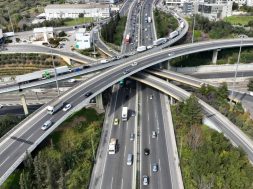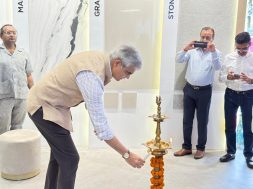Building industry is in intensive care: Hafeez Contractor
“As far as architecture is concerned, my philosophy is to look at the person, his needs and his budget and then design the most appropriate for that condition,” comments Architect Hafeez Contractor
Architecture, no doubt, is an art. Now the question comes: how the challenges like laws and economy affect the art architecture? In an exclusive interview with Afreen Sayed, Hafeez Contractor explains his philosophy on architecture and discusses his concerns for construction industry in the current economic situation.
Architecture sector has evolved over the years; what are the new trends?Architecture profession changes with time and economic situation. It changes with what kind of government is formed. Architecture also changes with demand and supply. Today the cost of construction is not only mounting, but galloping. This demands smaller, cheaper and more economical units.We cannot pinpoint cost today. Whatever cost we give, by the time tenders come out, it’s 30-40 per cent more. Further, we can expect a cost escalation of up to 30 per cent by the time building gets completed. At the moment building industry is not profitable. There is no security of anything. Repercussion is on the bylaws which keep on changing. Today we have one law, and we construct as per the law. Tomorrow the law is going to change, and we’ll not have any security.
The building industry, which was ‘the making industry’ once upon a time, is no longer that. This is very sad situation, but this is the fact.
What is your philosophy on architecture?My philosophy on architecture is finding the need and satisfy the need — the need of a person and finance. I am a need-based satisfying man, and that’s the most important thing. I do not have a big mantra for myself that I must do things only in this way. I would like to do things in the way that makes both you and me happy. While making you happy, I will put in all my expertise and knowledge and give you the most economical, practical and fast solutions.
Architecture is art of designing buildings. If I am designing an office building to glorify someone’s ego, my philosophy is different and if I am designing a house for an ordinary person, it is different. As far as architecture is concerned, my philosophy is to look at the person, his needs and his budget and then design the most appropriate for that condition. I do not have my way, my personality. I don’t want to imprint upon it, but when I design, my personality definitely comes into it.
What are the innovations happening in terms of architectural designing?Cement, steel, labour – all costs are going up. Today it’s not the thing of doing acrobats or flexing your muscles because that is going to increase my cost tremendously. Today how to design economic, faster and more appropriate structure is the mantra
What are the major projects you are currently working on?At any given time, we work on more than 600-700 projects. We have 20 groups; each group must be working on 40 projects. There are projects under construction, there are projects on drawing board and there are projects in pipeline.
You have worked in India and abroad. What are the differences you have witnessed in terms of work culture?Every country has a different work culture, but everybody wants the cheapest and fastest. That’s the culture around the world, and we are not different.
What are the challenges you face when working on a redevelopment project?When working on a redevelopment project, one should have the patience of a tortoise. Negotiations, demands and changes are unending. Sometimes, the laws are overlapping, but the architect has to follow all. I would say the building industry is in intensive care, with artificial respirators.
What can be done to improve this situation?We need definite laws and timely approvals.
Do you still believe growing vertical is the only way to meet the country’s requirement?In the last 7-8 years, world’s population has doubled — mostly in India and China. Today we are 1.1 billion and we will become 1.3 billion in the next 20-30 years. In old days, we used to have a joint family. Though the population was increasing, the demand for a house was one. Today the families are smaller so the demand for homes is higher.
Second thing is eating habits. Compare to the old days, wastage has become a style today. So, with the increasing population and to meet the demand for food, we need adequate lands for farming. If you go to Delhi, you’ll find most of the land is empty. What are you going to do there? We can make farms over there.
If we go vertical, our cities can be denser. Our transportation can be more economical. We can have mass transit and we don’t have to depend on fossil fuels or cars.
I feel the only way is growing vertical. The only survival is change the way you design your cities; design it not in two dimensions, but in four dimensions. Do your zoning in layers. Today we are doing zoning on sides – industrial, commercial, residential and garden. Commercial areas must be on the lower level, then the residential, and garden on top.
In most of the major cities, metro rails are coming up. How do you justify that and how useful this will prove?It is very essential that we have some mass transit. The only thing bothering me is that the metro is above ground. After 5-10 years, we will sense about what damage it is doing. I live in Dadar Parsi Colony. Just behind, there is a metro-line going above ground. The noise, the dust are urban blight. We cannot have trains in this age above ground with the kind of noise they will be creating. Roads are one place where you have the maximum greenery. Bangalore is a garden city.
When you go on the roads there, you feel splendid. If you cut those trees what will be left? We need metros, of course, but there are ways of doing things. Though underground metro is three times more expensive, I would prefer if the metro was underground. Look at the metro work in Andheri-Kurla Road; it’s a huge mess and looks awful. People should be out of their mind to do construction like this in this age. Metros in Gurgaon where areas are large and no construction around are acceptable. I am not saying you have one yardstick to judge everyone; you have to change. But the dense cities like Mumbai cannot have metro above ground. If you are making metro above ground, you are completely out of your mind.
“I feel the only way is growing vertical. The only survival is change the way you design your cities”
“The building industry, which was ‘the making industry’ once upon a time, is no longer that”
“My philosophy on architecture is finding the need and satisfy the need — the need of a person and finance”
“…But the dense cities like Mumbai cannot have metro above ground. If you are making metro above ground, you are completely out of your mind”
“Every country has a different work culture, but everybody wants the cheapest and fastest. That’s the culture around the world, and we are not different”
Cookie Consent
We use cookies to personalize your experience. By continuing to visit this website you agree to our Terms & Conditions, Privacy Policy and Cookie Policy.







